

"The critical realization was that some people’s minds are just super chaotic," Muse co-founder Chris Aimone told Wareable. These will be available as individual programs, but Muse says it plans to eventually roll out a feature that will integrate multiple feedback features. The band's pulse oximeter can now track your heart rhythms too, which will also be reflected in the audio feedback, while the breathing feature uses both movement and heart rhythms to track and guide your breathing technique. So now, you'll be able to get audio feedback to let you know you're shifting around too much (the headband surrounds you with invisible chimes that you'll hit if you move). As well as using the same weather-themed sounds, the Muse 2 also tracks body movements, breathing and heart rate. So this time around, the headband is equipped with other forms of real-time feedback to take some of the guesswork out of meditation. The idea was that the headband would help you reach a deep relaxed state - but for some people the auditory cues weren't enough to "switch off" from the outside world. Muse's first headband, which launched in 2014, converted this EEG signal into sounds reflecting the real-time state of your brain.
#Muse headband brain waves portable
All our journalism is independent and is in no way influenced by any advertiser or commercial initiative.īy clicking on an affiliate link, you accept that third-party cookies will be set.Muse has announced a new meditation headband - the Muse 2 - a portable electroencephalograph (EEG) device that tracks brain waves to help guide you into a meditative state. This article contains affiliate links, which means we may earn a small commission if a reader clicks through and Highs and lows are sensory peaks to be steered between. Plus, I have been to parties where the jays were really flying around and I have got to say they were far more relaxing, dude. It is hard to square the idea that simplicity, breath and the experience of being are best mediated by consumer electronics. But I suspect the wellness vogue has arisen in response to our constant attachment to devices. Perhaps, once the novelty wears off, this could be a useful tool for some. Is this what happens when Angry Birds get therapy? It’s fun, but should it be? Completing a certain number of sessions unlocks bird-themed milestones with weirdly twee names, such as “a party of jays”. You can rack up streaks, diamond-shaped “Muse points”, recovery rewards and wildlife icons on the app. Understandable, but it feels high-maintenance.
#Muse headband brain waves skin
A wet finger on the sensors increases their receptivity, but dry skin or hair slows things down. The band is light and secure, and it is usually possible to re-establish a dropped connection. It says things such as: “Unfortunately, calibration paused due to a drop in signal quality.” Imagine hearing that on the road to nirvana: you would be livid. Meditations are interrupted when your phone’s screen locks. Plus, when it comes to judging electrical brain activity, I am hardly infallible myself, despite divine promotion. There is more of a lag when it comes to mental stimulus, although the graphs at the end do roughly capture the shape of my experience. Muse 2 is excellent at detecting shifts in body posture.

During sessions, I hyperventilate or think about Fiona Bruce’s eyebrows, to see if it registers the spikes in heart rate. Minor movements of the eyes or tongue can contaminate EEG analysis, but it is impossible to know how well the device is adjusting for these. There are meditations for mind, heart, body and breathing, in which users becalm the weather, settle wind chimes and slow the rhythm of healing drums. I feel like Halle Berry in X-Men, or, if we are being honest, like God herself. “Control the weather with your mind,” it instructs me, casually. If I am distracted or agitated, the rain drums harder, like a monsoon. If I am calm, the rain gets softer and birds begin to sing. When I switch it on, a calm Canadian voice tells me: “Muse is now listening to your brain signals.” She explains the introductory meditation: a rainfall soundscape that alters to reflect my brain activity. ‘It looks as if a child has cut up his parent’s credit cards to make a contactless tiara’.


 0 kommentar(er)
0 kommentar(er)
